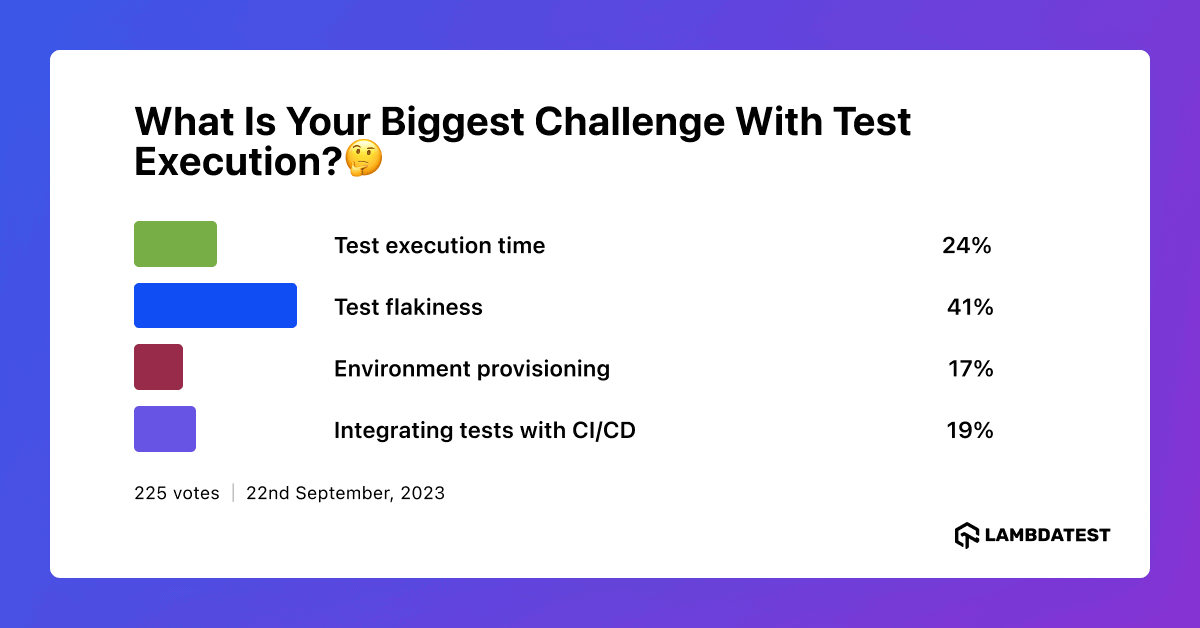Top 14 Challenges Faced In Agile Testing By Every Tester
Veethee Dixit
Posted On: March 18, 2024
![]() 646127 Views
646127 Views
![]() 14 Min Read
14 Min Read
Even though we strive for success in whatever journey we undertake, sometimes failure is inevitable. But in most cases, if we just avoid a few blunders and get through major challenges hampering progress, the path to success won’t seem so challenging. The same goes for agile testing teams where the pressure of continuous delivery can be overwhelming.
Now, I’m not telling you to aim for 100% perfection. ‘Figure out everything before leaving the room.’ Doesn’t this approach to sprint planning sound like a hostage situation? Agile testing teams usually try to eliminate the uncertainty factor as much as possible. But don’t you think keeping it short and effective would yield better results?
This was just an example of the hurdles that can actually sabotage a sprint! Speaking of which, in this article, I’m going to take a detailed look into some of the challenges in Agile Testing by every tester. So, let’s begin.
1. Not Keeping Up With Changing Requirements
Coming up with a good Agile testing plan is vital, no doubt about that. But if you believe that your plan is fool-proof and you won’t ever need to make modifications, think again. Most teams waste a lot of time trying to come up with an ideal Agile testing plan.
Now, although how much we’d like to achieve it, the truth is a perfect Agile testing plan does not exist. The complex environment won’t permit it. Sometimes, you have to make changes on an ad hoc basis. Or you might have to remove some processes. All in all, you have to be flexible and adapt to changes in the sprint, of course, keeping in mind that it all aligns with the sprint goal and you’d be ahead of all the challenges in Agile Testing.
2. Not Planning Cross Browser Testing
Most firms cease testing when their site successfully runs on primary browsers such as Google Chrome and the Mozilla Firefox. But do you really think you can have a wide customer base if your site runs well only on a handful of popular browsers?
After all, no customer wants to be restricted to a bunch of browsers. It takes away the versatile nature of business. You also can’t assume that if a web application or website works fine in one browser, the same would be the case for others. This is why it becomes important to ensure that your browser matrix is covered while performing cross browser testing. You can refer to our article on creating browser compatibility matrix to solve any challenges in agile testing due to not targeting the right browser!
Moreover, if you are using cutting edge technology, it’s also important to check whether your site works well in different browser versions. It’s important to note that cross browser testing provides a consistent behavior across various browsers, devices, and platforms. This increases your chances of having a wide customer base. You can even choose to utilise a Selenium Grid to scale your cross browser testing efforts.
Achieve the highest browser coverage, accurate testing, and easy debugging with the Real Time Testing feature on LambdaTest! LambdaTest is an AI-powered test orchestration and execution platform that lets you run manual and automated tests at scale on over 3000 real devices , browsers, and OS combinations.
You can also subscribe to the LambdaTest YouTube Channel and get the latest tutorials on Selenium visual regression testing, Playwright visual regression testing, Appium visual testing, and more.
Automate your app tests over 3000+ real devices and OS configurations. Try LambdaTest Now!
3. Failing To Incorporate Automation
Speaking strictly in business terms, time is money. If you fail to accommodate automation in your testing process, the amount of time to run tests is high, this can be a major cause of challenges in Agile Testing as you’d be spending a lot running these tests. You also have to fix glitches after the release which further takes up a lot of time.
If the company isn’t performing test automation the overall test coverage might be low . But as firms implement test automation, there is a sharp decline in the amount of time testers need for running different tests. Thus, it leads to accelerated outcomes and lowered business expenses. You can even implement automated browser testing to automate your browser testing efforts.
Moreover, you can always reuse automated tests and utilize them via different approaches. Teams can identify defects at an early stage which makes fixing glitches cost-effective. In the infographic linked below you can see the role of automation testing in Agile in a simple manner:
Role Of Automation Testing In Agile
4. Excessive Focus on Scrum Velocity
Most teams emphasize maximizing their velocity with each sprint. For instance, if a team did 60 Story Points the last time. So, this time, they’ll at least try to do 65. However, what if the team could only do 20 Story Points when the sprint was over?
Did you realize what just happened? Instead of making sure that the flow of work happened on the scrum board seamlessly from left to right, all the team members were concentrating on keeping themselves busy.
Sometimes, committing too much during sprint planning can cause challenges in Agile Testing. With this approach, team members are rarely prepared in case something unexpected occurs.
Under-committing can provide more room for learning and leaves more mind space to improve on present tasks. As a result, the collaboration between testers and developers gets better and they can get more work done in shorter time spans.
This approach also increases flexibility in the sprint backlog. In case, time permits, you can add more tasks later on. When you are under-committing, you also reduce the chances of carrying over the leftover work to the next sprint.
5. Lack of a Strategic Agile Testing Plan
Too much planning can cause challenges in Agile testing but that doesn’t mean you don’t plan at all! The lack of a strategic plan helps teams focus in the direction they are headed to. After all, can we even dream about delivering a project or pushing a release with no plan at all?
Benjamin Franklin has rightly said, “Failing to plan is planning to fail”. Having a basic guide to reach a goal or a vision assists team members in overcoming challenging situations. Therefore, after setting a goal, don’t forget to define the metrics necessary to reach your goal.
For instance, you can divide your plan into different phases. It’s a wise move to arrange meetings from time to time to review the progress and clear doubts. Some things to discuss during the meetings include sprint velocity, task estimation, and stretch goals.
The plan should be rigid enough to provide a direction to the team on how to work and instill confidence in team members. At the same time, it has to be flexible enough to incorporate changes and work on the feedback.
6. Considering Agile a Process Instead of a Framework
Even experienced developers or testers who have been in this for a while tend to think of Agile as just any other process . They fail to realize that it’s a framework that defines the entire development process. It also helps various teams in matching their requirements with preset guidelines.
Agile is about fine-tuning the process and making the required adjustments by using empirical data from shorter cycles of development and release. The team members should put their heads together in every sprint to improve with the aim of making each sprint more effective.
7. Micromanaging Agile Testing Teams
In a waterfall model, the management is responsible for setting a schedule and the pace for teams involved. This model has been in existence for a long time, thus making the management stick to previous practices and habits.
But in an Agile project, if the management closely observes and tries to control what the employees are doing all the time, failure in a sprint becomes inevitable. Agile testing teams are self-organizing. They are cross-functional and work together to achieve successful sprints.
Teams comprise motivated individuals who can make decisions and are flexible enough to adapt during times of change. Everyone is equally empowered working towards a common goal. But when you micromanage Agile testing teams, the constant interference can negatively affect the ability of employees to accomplish the goal in their own way.
If you take ownership and empowerment away from the team, there is no point in adopting an Agile framework.
8. Incoherency in Defining ‘Done’
My work here is done! Sounds so relieving, right? But when a person says this, what do they really mean by done? A developer can just check in the code and say that they’re done. On the other hand, some other developer can say this only when they are done with checking in, running tests and static analysis, etc.
Every person on the team has a different definition when they say ‘done’. But an incorrect interpretation about the same can put both employees and the management in a pickle. It can lead to incompletion of various tasks which can cause a lot of trouble, especially, at the end of a sprint.
Therefore, it’s important for everyone to be on the same page. When someone says that they have completed their tasks, they should maintain clarity and reveal the specifics.
9. Aiming for Perfection By Detailing an Agile Testing Plan
As discussed earlier, there is nothing worse than aiming for perfection and detailing out the Agile testing plan too much. It’s important to note that you can’t have all the information readily available at the beginning of the sprint.
The best thing to do is to settle for an Agile testing plan that’s good enough. This way, you won’t spend all your precious time planning. When you have more information, add to the Agile testing plan and make it better. Did you just end up with a killer Agile testing plan without wasting time planning it out? Well, that’s the beauty of Agile.
10. Mishandling of Carry Over Work
Now, no matter how much you try to be on time when it comes to accomplishing tasks of the sprint goal, you can’t completely avoid some carry over work. There is always going to be something left over when the sprint ends.
It’s tough to estimate the time the leftover tasks will take. Even if you are done with 75% of the task, the remaining 25% can take up a lot of time. To be safe, never underestimate the amount of work that is remaining. In this case, remember, overestimating won’t harm you.
Even if you end up overestimating the work, you can always add more if time permits later. But if you tend to underestimate, there are chances that there can be a tonne of leftover work when the sprint ends.
11. Lacking Skills and Experience With Agile Methods
Agile and scrum are relatively new in the tech industry. So, it’s understandable why people are not so experienced. It’s not possible to get your company to a flying start with sudden implementation of a new framework.
While the lack of experience itself is not a big issue, if you fail to address this in the short term, it’s going to cost you for the long haul. There is a risk of your employees falling back into the same old comfortable pattern of work.
The more you delay, the harder it gets to make your employees relinquish their comfort zone. So, to analyze the experience of different team members, hold meetings and conduct a thorough gap analysis. After that, when you get a vague idea, start educating them on the basics and work your way up to the more intricate parts.
12. Test Flakiness
Another obstacle in agile testing is test flakiness. The inconsistency in test results not only undermines the reliability but also poses a major hurdle in maintaining continuous integration and delivery pipeline, which is central to agile methodologies. It can take a lot of effort to find and fix these flaky tests. Flaky tests can also cause people to lack of confidence in the stability and quality of the software, delaying releases and impacting the overall efficiency of the agile testing process.
To gain deeper insights into this, we conducted a poll on LinkedIn asking professionals, ‘What is your biggest challenge with test execution? The varied responses revealed a common challenge: test flakiness. This highlights the importance of developing efficient strategies to streamline the testing process in Agile settings.

Ditch flakiness and automate tests seamlessly across 3000+ real devices and OS configurations. Try LambdaTest Now!
13. Technical Debt
Procrastination is one of the biggest challenges in Agile Testing due to its quick-paced nature. This attitude can pile up to a mountain of technical debt that’s harder to pay off than one might think. It’s tough to pay off the technical debt with the workload of an ongoing task. It also affects what you are currently working on in the case when you get too caught up in clearing the debt.
When you pick up something you put off earlier, the entire sprint will suffer. Sometimes, when the new tasks suffer due to extremely high technical debt, the sprint can even fail. This is one of the main reasons why you should avoid technical debts and overcome the associated challenges in Agile testing.
14. Compromised Estimation
The biggest mistake some teams do is that they start to treat estimations as accurate statistics. It’s important to note that the nature of estimations is vague! They can’t be accurate all the time. But in most cases, bad estimations are a result of the agile testing team failing to see the complexity or the depth of the user story or a task.
For instance, the developer can uncover dependencies in the user story in further stages of the sprint. This leads to unexpected delays by the implementation team. Now, in an agile framework, you can be prepared for minor delays. But what if 10-hours estimation turns to 20?
The team sometimes has to deal with such circumstances. But if compromised estimations occur on a frequent basis, the sprint format is likely to take a big hit. Therefore, you should be extra careful while making estimations so as to avoid inaccuracies as much as possible.
If you want to read more about automation testing in agile development, check out Why Automation Testing Is Important In Agile Development?
Final Words!
Always keep in mind, the holy grail of a sprint in the agile is flexibility. There are always going to be times when a particular step does not deliver the expected results. But agile is far from the ‘plan and execute’ approach. You have to be flexible and adaptive.
A deviation in the Agile testing plan or the occurrence of an obstacle is not the core issue here. Instead, how you eliminate as many challenges in agile testing as possible and deal with the existing ones determine the success of your sprint.
To sum up, I would like to say that if you stay mindful of the above challenges in agile testing, the chances of success increases substantially. So, the next time you plan a sprint, keep in mind the challenges in agile testing stated above. Try to overcome as many as possible and you’ll definitely notice a positive impact.
I hope you liked the article, and you’re ready to tackle these challenges when and where they occur. Share your challenges with us in the comment section down below. Also, don’t forget to share this article with your peers. Any retweet or share is always welcomed. That’s all for now! Happy Testing!!!
Got Questions? Drop them on LambdaTest Community. Visit now












